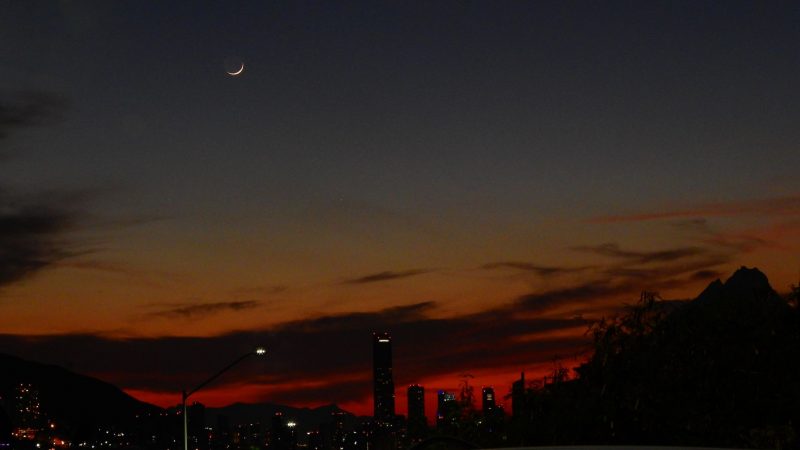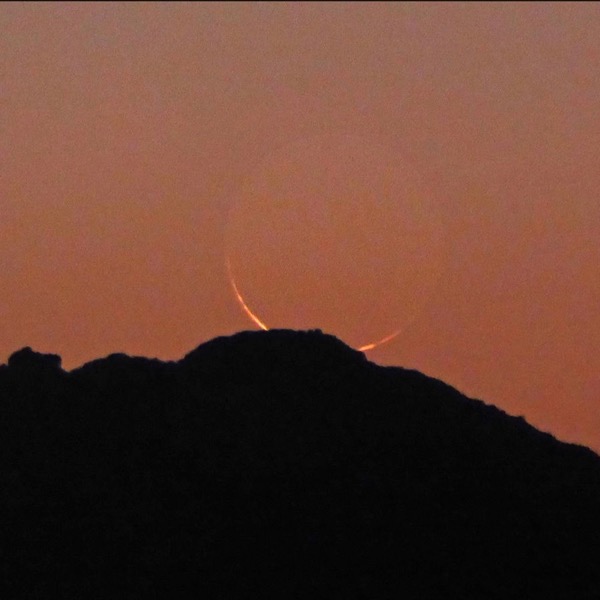By June 22, 2020, the annular solar eclipse has passed. From the Americas, it might have been possible to catch the skinniest of lunar crescents at dusk June 21, though binoculars would have been needed to glimpse the frail crescent that’s only about 0.5 percent illuminated in sunshine. For most of us, the young moon will return to the west after sunset on June 22, 23 and 24. Finding an unobstructed western horizon will be most helpful – especially on June 22 – when a whisker-thin lunar crescent will sit low in the west at sunset and will follow the sun beneath the horizon shortly thereafter. Most likely, on June 22, the thin crescent will set before nightfall. On the following evenings – June 23 and 24 – the young moon will be higher up after sunset and easier to see, but don’t delay. These young crescent moons all follow the sun below the western horizon in early evening.
Find out when the moon sets in your sky via TimeandDate.com
The moon swept to its new phase on June 21, 2020, at 06:41 UTC, giving birth to the new lunar month (Brown Lunation Number 1206).
Normally, the moon is not seen from Earth at new phase. At that time, the moon’s dark side is facing Earth, with the moon as a whole traveling near the sun in our daytime sky, lost in the sun’s glare. You’ll typically see the young moon return to the evening sky a day or two after new moon.
At the June 21 new moon, a number of people living in the world’s Eastern Hemisphere did see the moon during daylight hours. That’s because the new moon swung smack-dab in front of the sun, causing a solar eclipse. A small slice of the world saw this annular – or ring – solar eclipse. At mid-eclipse, the new moon silhouette was surrounded by a thin ring – or annulus – of the sun’s surface. A much larger swath of the world saw the new moon take a bite out of the solar disk: a partial eclipse of the sun.
Read more: Annular solar eclipse on June 21, 2020
Those who watched the June 21 solar eclipse – either in the sky or online – were viewing the moon’s night side. Now daylight is returning to the side of the moon we see. Assuming you don’t see the moon in your evening sky on June 21 (and most of us won’t), the first thin slice of illumination on the near side of the moon will be visible after sunset June 22.

Day by day, the moon moves a little over 12 degrees eastward of the setting sun. (For reference, the moon’s angular diameter spans about 1/2 degree of sky, and your fist at arm’s length measures approximately 10 degrees.) That means a wider lunar crescent will be higher in the sky at sunset, and will stay out longer after dark. In other words, the moon will be easier to catch after sundown on June 23 than on June 22, and on June 24 than June 23.

While you’re enjoying the beauty of a young moon these next several days, note the soft glow of earthshine on the dark side of the moon. Earthshine is twice-reflected sunlight, with sunlight reflected from Earth hitting the moon, and then bouncing back to Earth.
Read more: What is earthshine?
Bottom line: These next several days – June 22, 23 and 24, 2020 – watch for the young moon to adorn your western twilight sky.











